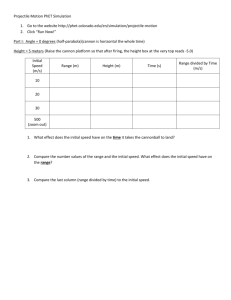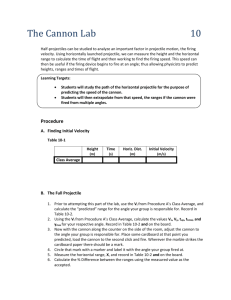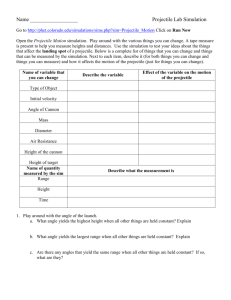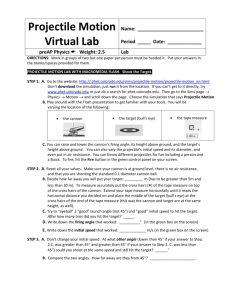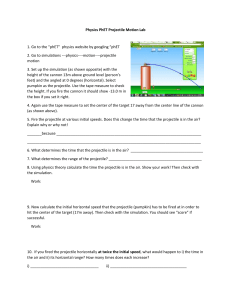pHet Projectile Lab
advertisement
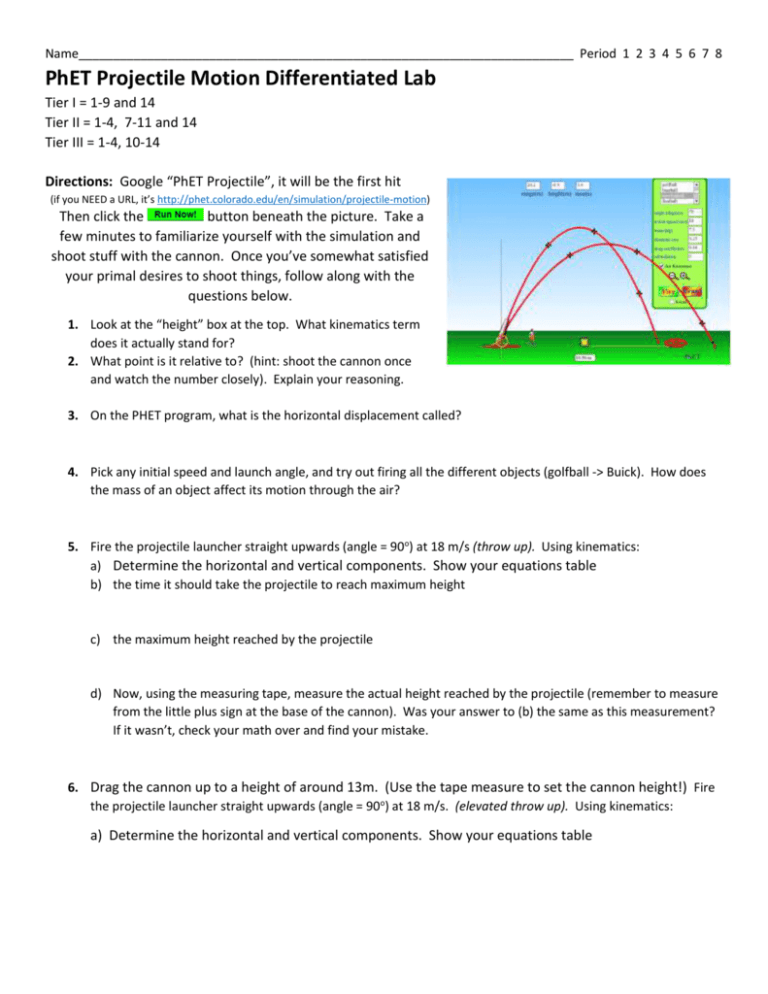
Name________________________________________________________________________ Period 1 2 3 4 5 6 7 8 PhET Projectile Motion Differentiated Lab Tier I = 1-9 and 14 Tier II = 1-4, 7-11 and 14 Tier III = 1-4, 10-14 Directions: Google “PhET Projectile”, it will be the first hit (if you NEED a URL, it’s http://phet.colorado.edu/en/simulation/projectile-motion) Then click the button beneath the picture. Take a few minutes to familiarize yourself with the simulation and shoot stuff with the cannon. Once you’ve somewhat satisfied your primal desires to shoot things, follow along with the questions below. 1. Look at the “height” box at the top. What kinematics term does it actually stand for? 2. What point is it relative to? (hint: shoot the cannon once and watch the number closely). Explain your reasoning. 3. On the PHET program, what is the horizontal displacement called? 4. Pick any initial speed and launch angle, and try out firing all the different objects (golfball -> Buick). How does the mass of an object affect its motion through the air? 5. Fire the projectile launcher straight upwards (angle = 90o) at 18 m/s (throw up). Using kinematics: a) Determine the horizontal and vertical components. Show your equations table b) the time it should take the projectile to reach maximum height c) the maximum height reached by the projectile d) Now, using the measuring tape, measure the actual height reached by the projectile (remember to measure from the little plus sign at the base of the cannon). Was your answer to (b) the same as this measurement? If it wasn’t, check your math over and find your mistake. 6. Drag the cannon up to a height of around 13m. (Use the tape measure to set the cannon height!) Fire the projectile launcher straight upwards (angle = 90o) at 18 m/s. (elevated throw up). Using kinematics: a) Determine the horizontal and vertical components. Show your equations table b) the time it should take the projectile to reach maximum height c)the maximum height reached by the projectile d) Now, using the measuring tape, measure the actual height reached by the projectile (remember to measure from the little plus sign at the base of the cannon). Was your answer to (b) the same as this measurement? If it wasn’t, check your math over and find your mistake. 7. Drag the cannon up to a height of around 13m. (Use the tape measure to set the cannon height!) Write in the an initial speed between 25m/s. Make sure the angle is 0o. (half projectile) a) Determine the horizontal and vertical components. Show your equations table. b)Calculate the range, height (distance) and time in the air. You must show your work c)Check your work with the program. Were your answers to (b) the same as this measurement? If it wasn’t, check your math over and find your mistake. 8. Drag the cannon back down to the ground level and select an angle for a launch. Write in an initial angle of 35o with an initial speed of 25m/s. (full projectile) a.)Sketch your setup in the space below. Label your launch angle. b) Determine the vertical and horizontal components of the projectile. Show your equation table c) Calculate the range, height (distance) and time in the air. You must show your work d) Check your work with the program. Were your answers to (c) the same as this measurement? If it wasn’t, check your math over and find your mistake. 9. Drag the cannon back up to a height of around 13m. (Use the tape measure to set the cannon height!) Write in an initial angle of 35o with an initial speed of 25m/s. (elevated projectile) a) Determine the horizontal and vertical components. Show your equations table. b) Calculate the range, height (distance) and time in the air. You must show your work c) Check your work with the program. Were your answers to (b) the same as this measurement? If it wasn’t, check your math over and find your mistake. 10. You are now going to investigate the effect of launch angle on several different parameters; air time, maximum height, and range. a) Fire the projectile launcher at the following angles (with the same initial speed of 18 m/s), then fill in the table below. You will need to use the measuring tape to measure the maximum height and the range. Angle Initial Speed (m/s) 10o 20o 30o 40o 50o 60o 70o 80o 90o 18 18 18 18 18 18 18 18 18 Air Time (s) Maximum Height (m) Range (m) b) What is the best angle for maximum height and air time? Explain why this is so. c) Is there a direct relationship between air time and range? Explain why or why not. This is an important question, make sure to give it some serious thought. d) Which of your angles above gave the most range? Explain why you think this is so. e) Rank your angles above from smallest to largest x-component of their velocities. Is there a direct relationship between the x-velocity of a projectile and its range? Explain why or why not. 11. In order to make things easier to see, drag the red target upwards so that it is on the x axis. This is essential for the next part; it makes it so the target is at the exact same height as the cannonball when it becomes a projectile (so dy = 0) We are going to try to show two interesting rules about projectile motion when dy = 0. a) Fire your launcher a bunch of times, in 5o increments (with the initial speed still set to 18 m/s). So, shoot it at 5o, 10o, 15o, 20o, etc (all the way up to 85o). Which of these angles gave the most range? Look at where your blue trajectory lines intersect the x-axis, not the ground below, since we are looking for patterns when dy = 0. b) Look at all of your blue trajectory lines. You’ll notice that some of them intersect the x-axis at the same points (that is, they have the same range for dy = 0). There is a pattern that exists here. You may need to conduct a few additional experiments to figure it out. Fill in the blanks below once you’ve found the rule. If dy = 0, and the initial speed is constant, two launch angles that add to _____ o will give the same range. c) Does varying the initial speed affect your results to parts (a) and (b)? Perform a quick experiment to test this out. Why do you think this is the case? d) What effect does doubling the initial speed have on the range of the projectile? Explain your results. e) Raise your cannon up into the air by dragging it up (see picture at right). Assuming the standard up = +y, right= +x coordinate system, will the vertical displacement of the cannonball from when it is fired to when it lands now be positive, negative, or zero? Don’t worry about complete sentences here. f) Now the dy does not equal zero. Perform an experiment to see if your results to (a) and (b) still hold true in this case. Discuss your results and explain them. 12. Reset the cannon back to the ground. This time, check the box. You can leave the drag coefficient and altitude at 1 and 0 where they are by default. Keep the red target on the x-axis as it was before. Start with the tankshell as your projectile. a) What effect does the mass of an object have on the maximum height and range when air resistance is turned on? Explain. b) What is the best angle for maximum range for the tankshell at an initial speed of 18 m/s when air resistance is turned on? Is this result different than when there was zero air resistance? Explain your results. c) Find the best angle for maximum range when dy = 0 (when the object hits your target) with four different objects. Record this information in the table below: Object Mass (kg) Angle for maximum range d) Is the angle for maximum range dependent on the mass of an object when air resistance is turned on? e) The fastest average drive speed in golf is held by Bubba Watson, coming in at 88.2 m/s (194 mi/h). Keep air resistance turned on, and switch your object to the golf ball. Using this simulator, decide which golf iron Bubba would get the most range with. There is a table below showing various parameters of each golf club. The “Loft” of a club is basically its launch angle. 13. Challenge time: hit the target. Make sure to turn air resistance off again, then raise the cannon to a certain height above the ground, and raise the target to a different height. Make sure that the target is reasonably far away from the cannon (in the x-direction). Record these heights below: Height of cannon = _______ m Height of target = _______ m a) Set your initial speed to 18 m/s. Using kinematics equations and your brain, determine a way to find the angle that will cause your projectile launcher to hit the target. (Hint: the initial velocity vector’s x and y components can be written as visinθ and vicosθ, respectively. This will make it possible to solve algebraically for θ. Don’t use guess and check) b) Now, set your angle to 60o, and find what initial speed you need to fire the cannon at in order to hit your target. Use the same hint from part (a) here. c) (This next problem was a free response problem on an AP Physics B exam several years ago): Move your cannon back to ground height, and set the initial speed back to 18 m/s and the launch angle to 65o. Place the target so that it is at a horizontal distance of 19 m from the cannon and a vertical distance of 8 m above the x-axis. Without actually firing the cannon, determine whether or not the projectile will clear the target (that is, go above it) or whether it will fall short (that is, wind up below it). Show all your work below including equation table. Once you’ve got a guess, fire it and see if you were correct. 14. What did you learn in this lab? What did it help you visualize that was somewhat unclear beforehand? Give me at least four complete sentences answering these questions.

